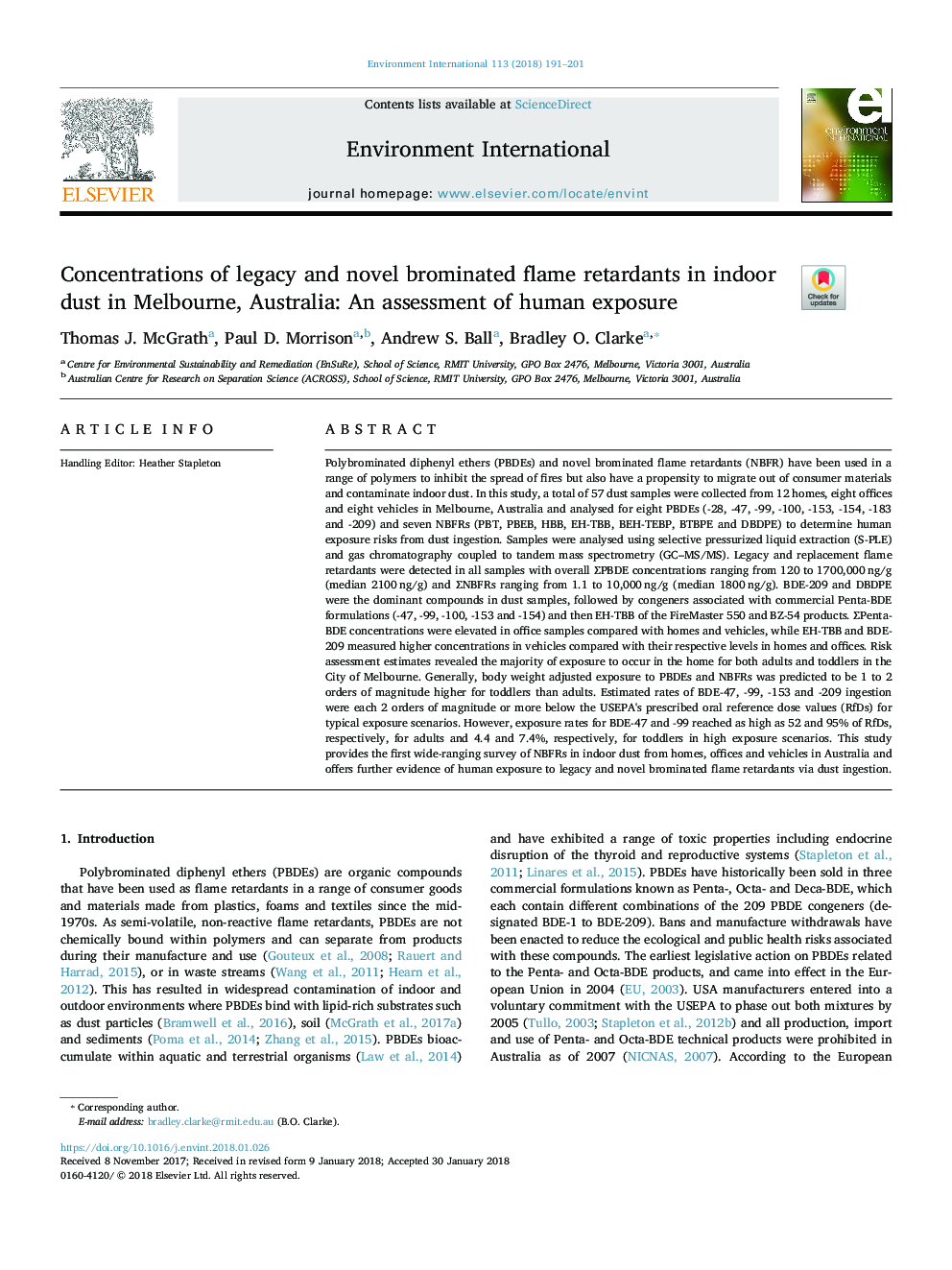| کد مقاله | کد نشریه | سال انتشار | مقاله انگلیسی | نسخه تمام متن |
|---|---|---|---|---|
| 8855373 | 1619017 | 2018 | 11 صفحه PDF | دانلود رایگان |
عنوان انگلیسی مقاله ISI
Concentrations of legacy and novel brominated flame retardants in indoor dust in Melbourne, Australia: An assessment of human exposure
ترجمه فارسی عنوان
غلظت ممانعت کننده ها و رقیق کننده های جدید برومند شعله در گرد و غبار داخلی در ملبورن، استرالیا: ارزیابی اثرات انسانی
دانلود مقاله + سفارش ترجمه
دانلود مقاله ISI انگلیسی
رایگان برای ایرانیان
موضوعات مرتبط
علوم زیستی و بیوفناوری
علوم محیط زیست
شیمی زیست محیطی
چکیده انگلیسی
Polybrominated diphenyl ethers (PBDEs) and novel brominated flame retardants (NBFR) have been used in a range of polymers to inhibit the spread of fires but also have a propensity to migrate out of consumer materials and contaminate indoor dust. In this study, a total of 57 dust samples were collected from 12 homes, eight offices and eight vehicles in Melbourne, Australia and analysed for eight PBDEs (-28, -47, -99, -100, -153, -154, -183 and -209) and seven NBFRs (PBT, PBEB, HBB, EH-TBB, BEH-TEBP, BTBPE and DBDPE) to determine human exposure risks from dust ingestion. Samples were analysed using selective pressurized liquid extraction (S-PLE) and gas chromatography coupled to tandem mass spectrometry (GC-MS/MS). Legacy and replacement flame retardants were detected in all samples with overall âPBDE concentrations ranging from 120 to 1700,000â¯ng/g (median 2100â¯ng/g) and âNBFRs ranging from 1.1 to 10,000â¯ng/g (median 1800â¯ng/g). BDE-209 and DBDPE were the dominant compounds in dust samples, followed by congeners associated with commercial Penta-BDE formulations (-47, -99, -100, -153 and -154) and then EH-TBB of the FireMaster 550 and BZ-54 products. âPenta-BDE concentrations were elevated in office samples compared with homes and vehicles, while EH-TBB and BDE-209 measured higher concentrations in vehicles compared with their respective levels in homes and offices. Risk assessment estimates revealed the majority of exposure to occur in the home for both adults and toddlers in the City of Melbourne. Generally, body weight adjusted exposure to PBDEs and NBFRs was predicted to be 1 to 2 orders of magnitude higher for toddlers than adults. Estimated rates of BDE-47, -99, -153 and -209 ingestion were each 2 orders of magnitude or more below the USEPA's prescribed oral reference dose values (RfDs) for typical exposure scenarios. However, exposure rates for BDE-47 and -99 reached as high as 52 and 95% of RfDs, respectively, for adults and 4.4 and 7.4%, respectively, for toddlers in high exposure scenarios. This study provides the first wide-ranging survey of NBFRs in indoor dust from homes, offices and vehicles in Australia and offers further evidence of human exposure to legacy and novel brominated flame retardants via dust ingestion.
ناشر
Database: Elsevier - ScienceDirect (ساینس دایرکت)
Journal: Environment International - Volume 113, April 2018, Pages 191-201
Journal: Environment International - Volume 113, April 2018, Pages 191-201
نویسندگان
Thomas J. McGrath, Paul D. Morrison, Andrew S. Ball, Bradley O. Clarke,
